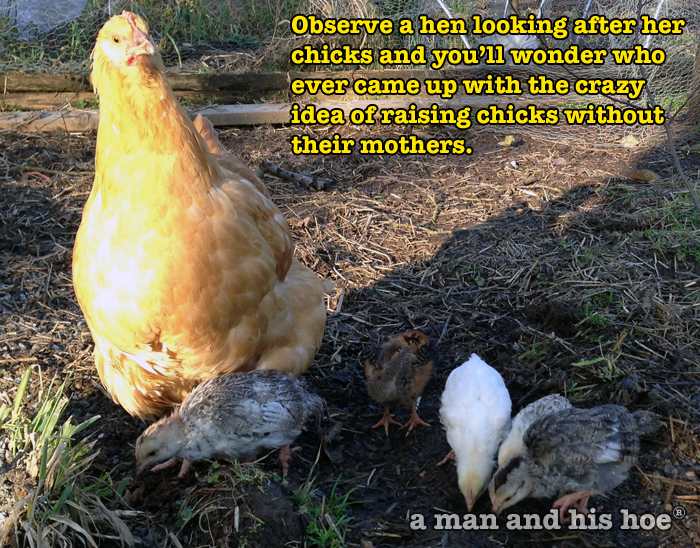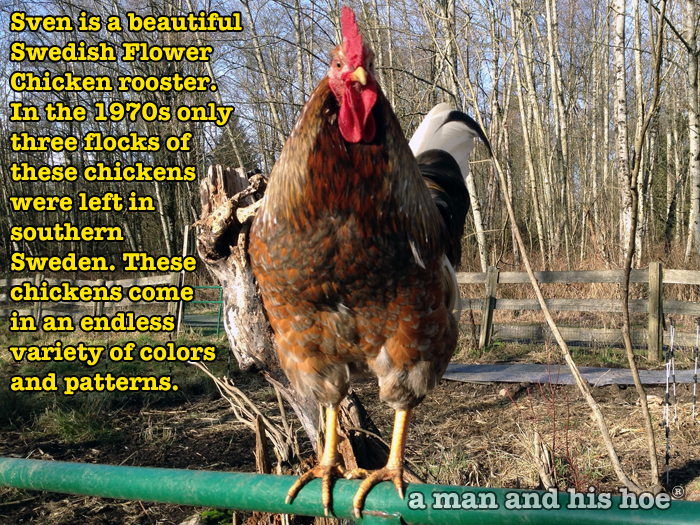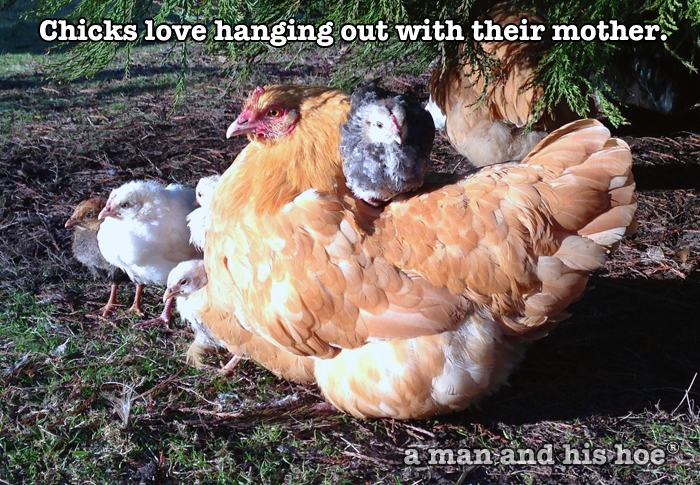Your cart is currently empty!
Tag: Raising chickens
-
All in a Morning

All in a Morning So just how far do chickens travel in a day? Much further than most people realize. In just three hours, the mother hen has taken her chicks over 600 feet through woods, pasture, and gardens. Over the course of a day she will take them from half a mile to a mile. This would be the equivalent of a person walking three to six miles.
I wonder what the psychological effects are on chickens which have very little room to move. I look at chickens being raised in 10 by 12 foot chicken tractors and can’t help but imagine they must be going mad. I’ve yet to see any of my chickens limit their daily movements to such a small space. Some of them travel so far I’m surprised they don’t get lost.
What I’ve observed with my chickens is that they don’t like to stay in one place very long. Even when they are in the midst of plenty to eat, they won’t stay more than five or ten minutes eating before moving on. It may an instinctual behavior to keep from being found by prey. Wild chickens which stay in one place too long may have a greater chance of being eaten than those which keep on the move. And if chickens have this instinctual need to keep moving, what happens to their psyche when they can’t?
-
Six Week Old Chicks – A Long Way to Go
[wpvideo 0Z1b3JZl]
When you watch these small six week old chicks running around with their mother, it’s hard to imagine that many broiler chickens are six pounds and ready to be butchered by six weeks. How is that possible? What happens to a chicken when it grows to six pounds in sex weeks. What would happen to a human child if it grew to the size of a large adult in four years?
-
The Most Important Things Have No Value

Hen and chicks looking for worms in the field. When you are outdoors taking care of chickens and crops, you realize how essential pure water, pure air, and non-toxic soil are. We need them. The chickens need them. The insects the chickens eat need them. All the plants need them. From the invisible bacteria in the compost heaps and soil, to the minute creatures which thrive on the bacteria, the insects, the earthworms, the moles, and on, we are all dependent on clean air we can breath, clean water to drink, environments free of toxins, those are the things that are most important to our health and well being.
But somehow we managed to create an economic and political system that puts no value on the things most important to us. We often hear the phrase jobs or the environment. Somehow we’ve come to accept the reasoning that in order for many of us to have jobs, we have to contaminate the things most important to our health and well being. And yet, if you consider the long term implications of this, if we have to keep making our environment more toxic to provide jobs, eventually the environment we live in will be so toxic that we won’t be alive.
In December, China reported that thousands of hectares of farmland were now too toxic to farm. According to this December 30, 2013, Reuters’ article, 3,000,000 hectares of land are now too polluted to farm. How is the destruction of 3,000,000 hectares of land accounted for in the balance sheet and profit and loss statements of the companies whose pollution destroyed this land? Oddly, it doesn’t show up. There is no value put on this tremendous loss of land.
Somehow, we’ve accepted an accounting system that puts no value on clean air, clean water, clean soil; the most important things not only to us but to all living things on this planet. The earth will still be spinning around the sun a thousand years from now, a million years from now, even a billion years from now. We need economic and political systems that will ensure that millions of years from now our air, water, and land will be even cleaner than they are now. Sadly our accounting systems are set up to only think three months ahead to what next quarter’s profits will be. In the context of a million years, next quarter’s profits are a pittance, but clean air, clean water, and clean earth are worth more than all the trillions of dollars recorded on balance sheets.
In a way, the compost piles I tend from the droppings of my chickens, is worth more than the profits of a factory filling the air with toxins. That compost pile is ensuring the purity of the earth. We need radically different accounting and political systems that revere chicken droppings and compost piles instead of plastics and pesticides.

No two hens are the same. -
Sven a Swedish Flower Chicken

Sven, a Swedish Flower Chicken The Swedish Flower Chicken is a landrace chicken that developed in Sweden. Landrace is a breed which has developed over time by adapting to the natural and cultural environment in which it lives.
Swedish Flower Chickens are colorful birds. No two are alike. Here are some links to other places raising these incredible birds:
Do searches of “Swedish Flower Chickens” or “Skånska Blommehöns” and you’ll find many more stories and images of these wonderful chickens.
[wpvideo E7LUiQgC]
-
Hanging Out With Mom

Hanging Out With Mom It doesn’t seem like January. The sun has been out all day and the chickens are having a great time. When you see how the chicks enjoy hanging out with their mother, even hopping on her back, isn’t it obvious that every chick deserves a mother?
Modern agriculture is all about efficiency. What is the least amount of feed we can give these chickens to raise them in the least amount of time to maximize profits? What is the least amount of money we can pay workers? What is the cheapest way we can ship this food? Those are the driving forces behind filling supermarkets with vast quantities of food. It’s not about maximizing your life and happiness.
But we are going to be on this planet for millions and millions of years to come. We need to expand our viewpoint and instead of running madly in a system driven by this quarter’s profits, we need to envision a system that will endure for millions of years and maximize happiness for everyone and everything, even the animals we raise. We are all interconnected in ways we can’t even imagine. Energy flows from one living thing to another. If you think about it, we are all just recycled chicken shit. The chickens eat the grains, the grasses, the berries. Their shit fertilizes the fields to grow incredible carrots, cabbages, and other vegetables. We eat those, so in a sense we are just eating recycled chicken shit. It all goes round and round. We all need to be healthy and happy, including the plants and animals we eat, to carry us through another million years.
[wpvideo kLXdDAHv]